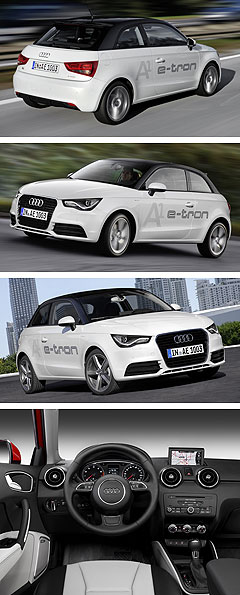First drive: Audi A1 e-tron a revolution too far?
BY BYRON MATHIOUDAKIS | 21st Nov 2011

Following on from last week’s commencement of a trial of 20 cars by selected university and utility companies in Germany, the media drive in Japan is the second phase in Audi’s quest to collect independent analysis and data in its plans for electrification mobility.
Debuting more than 18 months ago at the 2010 Geneva motor show, the A1 e-tron is a ‘Range Extender’, with its front wheels driven solely by an electric motor for up to 50km before a unique rotary internal combustion petrol engine connected to the battery pack (and not the wheels) fires up at constant revs to recharge the 270-volt lithium-ion batteries, providing about another 200km of range.
A plug-in outlet is cleverly incorporated behind the grille badge, with charging times rated at about eight hours.
It’s an elegant and intriguing solution – though one that still requires much development if refinement levels are going to match the current A1 1.2TFSI that Audi helpfully had on hand in Japan as a point of comparison.
We drove a ‘course’ of just 11km along a gentle and ultra smooth incline with a couple of kinks for corners and a nervous Audi Japan passenger to help with navigation and operation instructions.
Nevertheless, the A1 e-tron’s positive points are obvious the instant you poke the starter button.

Using a conventional floor-mounted lever, you can select either Pure Electric Drive (D) or Range Extender Drive (symbolised by the rotary combustion chamber’s famous Reuleaux triangle shape).
In either case, with sufficient charge, the electric motor is all that you will hear, so Audi tells us to select the latter for our short EV taster.
Matching the outputs of the volume-selling 1.2TSI, the transversely mounted permanent magnet synchronous electric motor delivers a peak of 75kW of power and 240Nm of torque.
As with most EVs, it is the lack of noise, combined with a turbine-style shove forward, that characterises initial acceleration, making the car feel faster than the outputs – and its 10.2-second time for the 0-100km/h sprint – might suggest.
Before we reach the 5km mark, a generator-like noise kicks in from somewhere behind the back seat, humming like a jet-plane in cruise mode. It is the engine and it is quite noticeable – and definitely a little too loud for a premium product like the A1.
A single-rotor engine with a capacity of just 254cc, it runs at a constant 5000rpm (“the optimal efficiency point”), providing 15kW of charge to the 22kWh lithium-ion batteries.
Audi says the range-extender rotary also operates at a lower (though less efficient) setting of about 2000rpm for topping-up the battery pack less urgently when the car is cruising along.
Whichever way, hopes of enjoying the uplifting zing of a Mazda rotary singing its way up the rev range were sorely dashed, not least because of the very CVT-like drone from the Audi engine.
At least the rotary range-extender is not likely to break the fuel budget. Fuel consumption is 1.9 litres per 100km, with carbon dioxide emissions rated at 45 grams per kilometre, according to the new European NEDC system.
Interestingly, the diesel-powered Volvo V60 PHEV hybrid achieves the same figure.
Audi confirmed that figure is calculated over the entire distance travelled over a set course that includes non-range-extender driving periods. Calculated using a similar method, General Motors claims the considerably larger Chevrolet Volt can achieve 1.2L/100km.
Except for the quiet turbine performance before the rotary din commences, there isn’t much that differs from the regular A1.
The electro-hydraulic power steering feels much the same, the brakes haul the e-tron up with the usual responsiveness and the suspension on the ultra-smooth surface did its job admirably – although most of this brand’s vehicles behave similarly until the going gets rough.
Audi said a lower centre of gravity and better weight distribution, as a result of the 65kg range-extender engine out back, improve the dynamics slightly.
The e-tron is apparently “in the region” of about 150kg heavier than a regular A1.
Just 11km in super-controlled conditions did not really reveal much more, but it is clear that, while the A1 e-tron looks production ready, there is still much work to be completed in the areas of noise suppression, at the very least.
Even almost two years on from its debut, senior Audi officials again declined to even confirm plans for A1 e-tron production, let alone divulge a possible release date.
Speculation suggests the company may wait until the next-generation A1 comes along before releasing this range-extender technology – if at all.
So, while this car’s future is still very much up in the air, at least it shows that Audi is investigating a range of interesting and viable possibilities.
The A1 evolution – as opposed to a rotary revolution – continues.